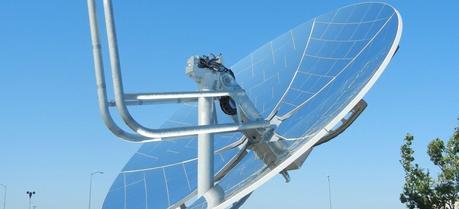 PNNL’s concentrating solar power system for natural gas power plants, installed on a mirrored parabolic dish. (Courtesy of Pacific Northwest National Laboratory)
PNNL’s concentrating solar power system for natural gas power plants, installed on a mirrored parabolic dish. (Courtesy of Pacific Northwest National Laboratory)A new study suggests that connecting concentrating solar power (CSP) plants together could provide a considerable part of electrical energy demand at costs comparable to other energy technologies.
CSP systems use mirrors or lenses to reflect and concentrate sunlight. Electrical power is produced when the concentrated light is converted to heat, which drives a heat engine (usually a steam turbine).
SEE ALSO: CSIRO Uses Solar Energy to Generate Supercritical Steam
Results of the study published in the journal Nature Climate Change (see footnote), have shown that in the Mediterranean region, for example, a connected CSP system could provide 70-80% of current electricity demand at costs comparable to other technologies that provide a stable power supply. This is comparable to energy production levels of a standard energy production plant, such as a nuclear power plant.
Stefan Pfenninger, from Department of Civil and Environmental Engineering, who is currently working towards a Ph.D. at the Grantham Institute at Imperial College London said: “Our results show that this solar energy system can satisfy up to 80% of our hunger for electricity, at not much more cost than traditional sources. This is the first study to systematically examine the potential of CSP to overcome the inherent variability of solar energy.”
One problem with deploying solar energy on a large scale is that the sun does not shine all the time, so the energy must be stored in some way. International Institute for Applied Systems Analysis (IIASA) researcher Fabian Wagner, who also worked on the study, explains: “Unlike PV, CSP uses the sun’s energy to heat up a liquid that drives turbines. This means that the collected energy can be stored as heat, and converted to electricity only when needed.”
The researchers simulated the construction and operation of connected CSP systems in four regions around the world: the Mediterranean, South Africa, India and the United States of America. The simulations took account of weather variation, such as solar radiation, surface temperature and wind, as well as plant location, electricity demand and costs.
Results showed that connected CSP plants could provide up to 80% of current electricity demand, at little to no extra cost. The researchers also showed that by doubling the surface area to trap the sun’s energy in each plant, connected CSP plants are able to create large enough heat reserves to compensate for times when the sun is not shining. This means that if one plant goes offline because of poor weather conditions, energy stored at another CSP plant could be used.
IIASA researcher Fabian Wagner said: “To address climate change we need to greatly expand our use of renewable energy systems. The key question, though, is how much energy renewable systems can actually deliver. Our study, which is the first to systematically assess how you would operate a fleet of CSP plants, shows that CSP offers massive potential as a reliable renewable energy source.”
It has been suggested that the renewable energy source CSP could be scaled up to offer a high level of reliable power, without having to integrate different energy sources to feed demand. This study delivers strong evidence supporting the feasibility of such a plan.
Pfenninger, S., Gauché, P., Lilliestam, J., Damerau, K., Wagner, F., & Patt, A. (2014). Potential for concentrating solar power to provide baseload and dispatchable power Nature Climate Change DOI: 10.1038/nclimate2276
